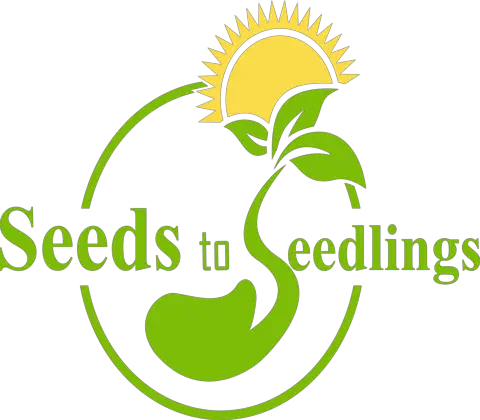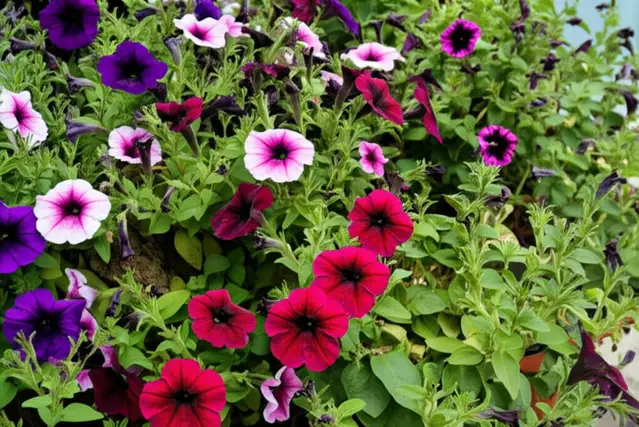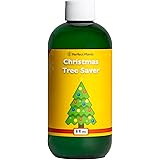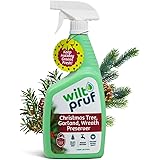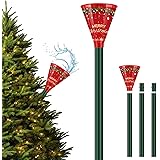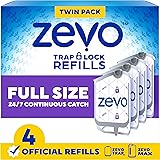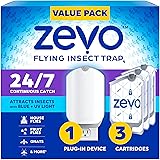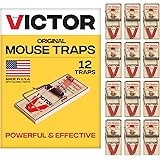Petunias, with their vibrant colors and cascading blooms, are a favorite among gardeners. Whether you’re a seasoned pro or just starting out, understanding the best soil for potted petunias is crucial for achieving healthy, flourishing plants.
This comprehensive guide will walk you through everything you need to know, from soil composition to DIY mixes, ensuring your petunias thrive in their containers.
Why Soil Matters for Petunias
Soil is more than just a medium for plants to stand in. It provides essential nutrients, supports root growth, and regulates moisture levels. For petunias, which are heavy feeders and require well-draining soil, the right soil can make all the difference between a plant that struggles and one that thrives.
Key Soil Requirements for Petunias
- Well-Draining: Petunias hate soggy soil, which can lead to root rot.
- Nutrient-Rich: These plants need a steady supply of nutrients for continuous blooming.
- Slightly Acidic: A pH level between 6.0 and 6.5 is ideal.
- Good Aeration: Roots need oxygen to grow properly.
Understanding Soil Composition
The ideal soil for petunias is a carefully balanced mix of several components. Let’s break down each element:
1. Soil Types
- Loam: Loam is the gold standard for garden soil. It’s a balanced mix of sand, silt, and clay, offering good drainage, aeration, and nutrient retention.
- Sandy Soil: Sandy soil drains quickly and is well-aerated, but it doesn’t retain nutrients or moisture well.
- Clay Soil: Clay soil retains water and nutrients effectively but can become compacted and poorly aerated.
- Silty Soil: Silty soil has good water retention but can be prone to compaction.
2. Organic Matter
Organic matter is decomposed plant and animal material. It improves soil structure, water retention, and nutrient availability. Common types of organic matter include:
- Compost: Decomposed organic waste that adds nutrients and improves soil structure. If you are planning to make your own compost check out how to make homemade compost.
- Peat Moss: Decomposed sphagnum moss that retains moisture and improves soil aeration.
- Coco Coir: Made from coconut husks, coco coir is a sustainable alternative to peat moss with excellent water retention and aeration.
- Well-Rotten Manure: Adds nutrients and improves soil structure, but should be well-rotted to avoid burning the roots.
3. Amendments
Amendments are materials added to the soil to improve its physical and chemical properties. Common amendments include:
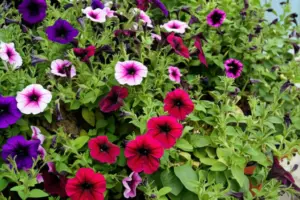
- Perlite: Volcanic glass that improves drainage and aeration.
- Vermiculite: A mineral that retains water and nutrients while improving aeration.
- Sand: Coarse sand can improve drainage in heavy soils. Be sure to use sharp sand for garden drainage; it’s the unsung hero of lush gardens.
- Lime: Used to raise the pH of acidic soils.
- Sulfur: Used to lower the pH of alkaline soils. You should also know what sulfur do for plants.
Best Soil Mixes for Potted Petunias
Now that you understand the components, let’s look at some specific soil mixes that work well for petunias in pots.
1. Commercial Potting Mix
High-quality commercial potting mixes are often the easiest option. Look for mixes specifically formulated for flowering plants. These mixes typically contain a blend of peat moss, perlite, vermiculite, and slow-release fertilizers.
Pros:
- Convenient and readily available.
- Consistent quality and composition.
- Often contains added fertilizers.
Cons:
- Can be more expensive than DIY mixes.
- May not be suitable for all types of petunias.
2. DIY Potting Mix
Creating your own potting mix allows you to customize the blend to meet the specific needs of your petunias. Here are a couple of proven recipes:
Recipe 1: Basic Mix
This mix is suitable for most petunia varieties.
- 1 part garden soil (loam)
- 1 part peat moss or coco coir
- 1 part perlite or vermiculite
Recipe 2: Nutrient-Rich Mix
This mix provides extra nutrients for heavy-blooming petunias.
- 1 part compost
- 1 part peat moss or coco coir
- 1 part perlite or vermiculite
- A handful of slow-release fertilizer
Pros:
- Cost-effective.
- Customizable to specific plant needs.
- Avoids potential additives in commercial mixes.
Cons:
- Requires sourcing and mixing ingredients.
- Can be time-consuming.
- Quality can vary depending on ingredient sources.
3. Soilless Mix
A soilless mix is a blend of organic and inorganic materials that doesn’t contain any actual soil. It’s lightweight, well-draining, and sterile, making it a good option for petunias in containers.
A common soilless mix recipe includes:
- 1 part peat moss or coco coir
- 1 part perlite
- 1 part vermiculite
Pros:
- Excellent drainage and aeration.
- Lightweight, making it easy to move containers.
- Sterile, reducing the risk of soilborne diseases.
Cons:
- Doesn’t provide as many nutrients as soil-based mixes.
- Requires regular fertilization.
Step-by-Step Guide to Potting Petunias
Once you have your soil mix ready, follow these steps to pot your petunias:
- Choose the Right Container: Select a pot with drainage holes to prevent waterlogging. The size of the pot should be appropriate for the size of the plant.
- Prepare the Pot: Add a layer of gravel or broken pottery to the bottom of the pot to improve drainage.
- Add Soil: Fill the pot with your chosen soil mix, leaving a few inches of space at the top.
- Plant the Petunia: Gently remove the petunia from its nursery container and loosen the roots. Place the plant in the pot and add more soil around the roots, ensuring the top of the root ball is level with the soil surface. If you forgot to loosen root ball don’t worry it’s a common mistake.
- Water Thoroughly: Water the newly potted petunia until water drains out of the bottom of the pot.
- Mulch (Optional): Add a layer of mulch, such as shredded bark or straw, to help retain moisture and suppress weeds.
Maintaining Optimal Soil Conditions
Proper soil is just the beginning. Maintaining the right conditions is essential for keeping your petunias healthy and blooming.
1. Watering
Petunias need consistent moisture, but they don’t like to sit in soggy soil. Water thoroughly when the top inch of soil feels dry to the touch. Avoid overhead watering, which can lead to fungal diseases.
2. Fertilizing
Petunias are heavy feeders and benefit from regular fertilization. Use a balanced, water-soluble fertilizer every 2-3 weeks, or a slow-release fertilizer according to the package instructions. Consider using best homemade liquid fertilizer for indoor plants.
3. pH Monitoring
Maintain a soil pH between 6.0 and 6.5. Use a soil pH meter to monitor the pH level and adjust as needed with lime or sulfur. Also you should know is sulfur water bad for plants.
4. Soil Aeration
Over time, the soil in pots can become compacted, reducing aeration. Gently loosen the soil surface with a hand fork or cultivator every few weeks to improve air circulation.
5. Repotting
As petunias grow, they may outgrow their containers. Repotting into a larger pot with fresh soil can rejuvenate the plant and provide more room for root growth. It is also important to know when to fertilize after repotting.
Troubleshooting Common Soil Problems
Even with the best soil, problems can arise. Here are some common issues and how to address them:
1. Poor Drainage
Symptoms: Yellowing leaves, wilting, root rot.
Solutions:
- Ensure the pot has adequate drainage holes.
- Add more perlite or sand to the soil mix.
- Avoid overwatering.
- Repot into a well-draining mix.
2. Nutrient Deficiency
Symptoms: Yellowing leaves, stunted growth, poor flowering.
Solutions:
- Fertilize regularly with a balanced fertilizer.
- Check soil pH and adjust if necessary.
- Add compost or other organic matter to the soil.
3. Soil Compaction
Symptoms: Slow growth, poor water penetration, rootbound plants.
Solutions:
- Aerate the soil regularly.
- Repot into fresh, well-aerated soil.
- Add organic matter to improve soil structure.
4. pH Imbalance
Symptoms: Yellowing leaves, nutrient deficiencies.
Solutions:
- Test soil pH regularly.
- Add lime to raise pH in acidic soils.
- Add sulfur to lower pH in alkaline soils.
Choosing the Right Pot
The pot itself plays a significant role in the health of your petunias. Here are some considerations:
1. Material
- Terracotta: Terracotta pots are porous, allowing for good air circulation and drainage. However, they can dry out quickly.
- Plastic: Plastic pots retain moisture well and are lightweight, but they don’t breathe as well as terracotta.
- Ceramic: Ceramic pots are decorative and retain moisture, but they can be heavy.
- Resin: Resin pots are durable, lightweight, and come in various styles, but they may not breathe as well as terracotta.
2. Size
The size of the pot should be appropriate for the size of the plant. Petunias need room for their roots to grow, but a pot that’s too large can lead to overwatering.
Here’s a general guideline:
- Small petunias: 6-8 inch pot
- Medium petunias: 8-12 inch pot
- Large petunias: 12+ inch pot
3. Drainage
Ensure the pot has adequate drainage holes. If the pot doesn’t have enough holes, you can drill additional ones.
Petunia Varieties and Their Soil Preferences
While most petunias thrive in similar soil conditions, some varieties may have slightly different preferences. Here’s a brief overview:
1. Grandiflora Petunias
Grandifloras have large, single or double blooms. They prefer well-draining, nutrient-rich soil with a slightly acidic pH.
2. Multiflora Petunias
Multifloras have smaller, more numerous blooms and are more weather-resistant than grandifloras. They also prefer well-draining, nutrient-rich soil with a slightly acidic pH.
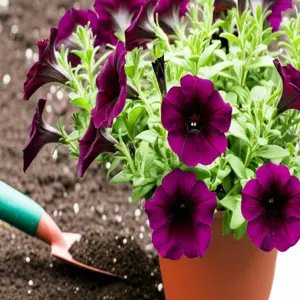
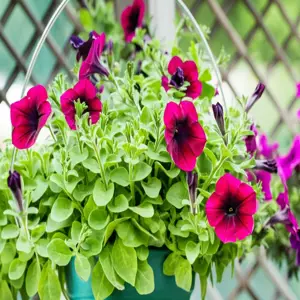
3. Milliflora Petunias
Millifloras are compact and have very small blooms. They’re ideal for containers and hanging baskets and prefer well-draining soil with a slightly acidic pH.
4. Spreading Petunias (Wave Petunias)
Spreading petunias, like Wave petunias, are known for their vigorous growth and spreading habit. They need well-draining, fertile soil to support their extensive growth.
Other Important Factors for Petunia Care
Soil is a critical component, but several other factors contribute to the health and beauty of your petunias.
1. Sunlight
Petunias need at least 6 hours of direct sunlight per day. Place your potted petunias in a sunny location to encourage abundant blooming.
2. Temperature
Petunias prefer temperatures between 60°F and 75°F (15°C and 24°C). Protect them from frost and extreme heat.
3. Pruning
Regularly deadhead spent blooms to encourage continuous flowering. Pinch back leggy stems to promote bushier growth.
4. Pest and Disease Control
Monitor your petunias for pests like aphids, spider mites, and whiteflies. Treat infestations promptly with insecticidal soap or neem oil. Prevent fungal diseases by avoiding overhead watering and ensuring good air circulation.
Table: Summary of Best Soil Mixes for Potted Petunias
| Soil Mix | Ingredients | Pros | Cons | Best For |
|---|---|---|---|---|
| Commercial Potting Mix | Peat moss, perlite, vermiculite, slow-release fertilizer | Convenient, consistent quality, often contains fertilizer | Can be expensive, may not suit all varieties | Beginners, those seeking convenience |
| DIY Basic Mix | 1 part garden soil, 1 part peat moss/coco coir, 1 part perlite/vermiculite | Cost-effective, customizable | Requires sourcing ingredients, time-consuming | General use, cost-conscious gardeners |
| DIY Nutrient-Rich Mix | 1 part compost, 1 part peat moss/coco coir, 1 part perlite/vermiculite, slow-release fertilizer | Extra nutrients, customizable | Requires sourcing ingredients, time-consuming | Heavy-blooming petunias |
| Soilless Mix | 1 part peat moss/coco coir, 1 part perlite, 1 part vermiculite | Excellent drainage, lightweight, sterile | Requires regular fertilization | Containers, reducing disease risk |
Frequently Asked Questions (FAQ)
What is the ideal pH level for petunia soil?
The ideal pH level for petunia soil is between 6.0 and 6.5, which is slightly acidic. This range allows petunias to efficiently absorb nutrients from the soil.
Can I use garden soil for potted petunias?
While you can use garden soil, it’s generally not recommended for potted petunias. Garden soil can be too heavy, poorly draining, and may contain pests or diseases. It’s better to mix garden soil with other ingredients to improve its texture and drainage. You should also know can you use garden soil with houseplants.
How often should I fertilize my potted petunias?
Fertilize your potted petunias every 2-3 weeks with a balanced, water-soluble fertilizer, or use a slow-release fertilizer according to the package instructions. Regular fertilization is essential for heavy blooming.
What are the signs of overwatering petunias?
Signs of overwatering include yellowing leaves, wilting, and root rot. The soil may also feel soggy to the touch. Ensure your pot has good drainage and allow the soil to dry slightly between waterings.
How can I improve drainage in my petunia pots?
To improve drainage, add perlite or coarse sand to your soil mix. You can also place a layer of gravel or broken pottery at the bottom of the pot. Make sure the pot has adequate drainage holes.
Is coco coir a good alternative to peat moss for petunias?
Yes, coco coir is an excellent and sustainable alternative to peat moss. It retains moisture well, improves soil aeration, and has a neutral pH. If you are struggling with terrarium, check out how to make a terrarium with air plants.
Can I use coffee grounds for petunias?
Yes, you can use coffee grounds sparingly for petunias. Coffee grounds are slightly acidic and can add nutrients to the soil. However, use them in moderation, as too many coffee grounds can make the soil too acidic. Also you should know *do roses like coffee grounds*.
What is the best type of fertilizer for petunias?
The best type of fertilizer for petunias is a balanced, water-soluble fertilizer with an N-P-K ratio of 10-10-10 or 20-20-20. You can also use a fertilizer specifically formulated for flowering plants.
How do I know if my petunias need repotting?
Signs that your petunias need repotting include roots growing out of the drainage holes, slow growth, and the plant becoming rootbound. Repot into a larger pot with fresh soil to rejuvenate the plant.
What can I do to prevent soilborne diseases in my petunia pots?
To prevent soilborne diseases, use a sterile potting mix, avoid overwatering, and ensure good air circulation around the plants. You can also use a fungicide if necessary.
Conclusion
Choosing the best soil for potted petunias is a critical step in ensuring vibrant, healthy plants. By understanding the key requirements of petunias – well-draining, nutrient-rich, and slightly acidic soil – you can select the right mix, whether it’s a commercial blend or a DIY concoction. Remember to maintain optimal soil conditions through proper watering, fertilizing, and pH monitoring. With the right soil and care, your petunias will reward you with a stunning display of colorful blooms all season long.
Furthermore, don’t underestimate the importance of other factors like sunlight, temperature, and pruning. Regular maintenance and attention to detail will keep your petunias thriving. Whether you’re growing grandifloras, multifloras, or spreading petunias, the principles remain the same: provide the right soil, the right care, and watch your petunias flourish.
Gardening is a journey of learning and experimentation. Don’t be afraid to try different soil mixes and techniques to find what works best for you and your petunias. Every garden is unique, and with a little patience and knowledge, you can create a beautiful and thriving display of petunias in pots.
Auto Amazon Links: No products found.
Perfect Plants Christmas Tree Saver 8oz. | Easy Use Xmas Tree Preserver Food | Have Healthy Green Christmas Trees All Holiday Season
$9.97 (as of November 25, 2025 23:26 GMT +00:00 - More info- Product prices and availability are accurate as of the date/time indicated and are subject to change. Any price and availability information displayed on [relevant Amazon Site(s), as applicable] at the time of purchase will apply to the purchase of this product.
Wilt-Pruf® Christmas Tree/Cutting Preserver Spray |Preserves Christmas Trees, Wreaths, Garlands, Cuttings and Carved Pumpkins | Reduces Needle Drop | Keeps Cut Trees Fresh Longer | Natural (32 oz)
$21.99 (as of November 25, 2025 23:26 GMT +00:00 - More info- Product prices and availability are accurate as of the date/time indicated and are subject to change. Any price and availability information displayed on [relevant Amazon Site(s), as applicable] at the time of purchase will apply to the purchase of this product.
Christmas Tree Watering Funnel – 39 Inch Adjustable 3-Section Design, Reusable & Spill-Free, Easy Watering for Real Christmas Trees
$10.70 (as of November 25, 2025 23:26 GMT +00:00 - More info- Product prices and availability are accurate as of the date/time indicated and are subject to change. Any price and availability information displayed on [relevant Amazon Site(s), as applicable] at the time of purchase will apply to the purchase of this product.
HoHoHoH2o Automatic Christmas Tree Watering System Device, Santa’s Tree Helper Keeps Your Christmas Tree Healthy and Fresh, Refillable 2.5 gallons Capacity Box - Silver/Festive
$99.95 (as of November 25, 2025 23:26 GMT +00:00 - More info- Product prices and availability are accurate as of the date/time indicated and are subject to change. Any price and availability information displayed on [relevant Amazon Site(s), as applicable] at the time of purchase will apply to the purchase of this product.
IPOOLTENG Christmas Tree Watering Funnel 3 Tube 1 Funnels 40 Inch - 3 Section Plastic Christmas Tree Funnel Waterer, Long Funnels for Watering Trees, No More Bending to Water
$13.59 (as of November 25, 2025 23:26 GMT +00:00 - More info- Product prices and availability are accurate as of the date/time indicated and are subject to change. Any price and availability information displayed on [relevant Amazon Site(s), as applicable] at the time of purchase will apply to the purchase of this product.
Zevo Flying Insect Trap Official Refill Cartridges - Fits Both Zevo Trap & MAX Indoor Fly Trap - Authentic Trap+Lock Technology to Catch Gnats, House & Fruit Flys (4 Official Refill Cartridges)
$14.97 (as of November 25, 2025 14:47 GMT +00:00 - More info- Product prices and availability are accurate as of the date/time indicated and are subject to change. Any price and availability information displayed on [relevant Amazon Site(s), as applicable] at the time of purchase will apply to the purchase of this product.
Traeger Grills Signature Blend 100% All-Natural Wood Pellets for Smokers and Pellet Grills, BBQ, Bake, Roast, 18 lb. Bag
$19.99 (as of November 25, 2025 14:47 GMT +00:00 - More info- Product prices and availability are accurate as of the date/time indicated and are subject to change. Any price and availability information displayed on [relevant Amazon Site(s), as applicable] at the time of purchase will apply to the purchase of this product.
TERRO Ant Killer Bait Stations T300B - Liquid Bait to Eliminate Ants - Bait System - 12 Count Stations for Effective Indoor Ant Control
$10.86 (as of November 25, 2025 14:47 GMT +00:00 - More info- Product prices and availability are accurate as of the date/time indicated and are subject to change. Any price and availability information displayed on [relevant Amazon Site(s), as applicable] at the time of purchase will apply to the purchase of this product.
Zevo Flying Insect Trap & 3 Refill Cartridges - Plug in Fly Trap & Indoor Bug Catcher for Gnats, House & Fruit Flies - Blue & UV Light Technology, Mess-Free Alternative to Bug Zapper
$25.96 (as of November 25, 2025 14:47 GMT +00:00 - More info- Product prices and availability are accurate as of the date/time indicated and are subject to change. Any price and availability information displayed on [relevant Amazon Site(s), as applicable] at the time of purchase will apply to the purchase of this product.
Victor Mouse Traps M150-12, Metal Pedal, Sustainably Sourced FSC Wood, Wooden Mouse Traps, 12 Metal Pedal Traps
$9.79 (as of November 25, 2025 14:47 GMT +00:00 - More info- Product prices and availability are accurate as of the date/time indicated and are subject to change. Any price and availability information displayed on [relevant Amazon Site(s), as applicable] at the time of purchase will apply to the purchase of this product.
